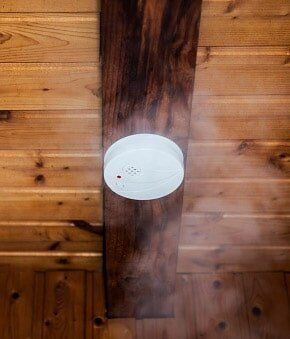SMOKE DETECTOR REPAIR IN THE GREATER PHOENIX AREA

No two smoke detector or smoke alarm models
operate the same way. One cannot look at a smoke detector or smoke alarm and make any assumptions about what the indicator lights may mean. The only way to tell with certainty what the indicator lights may mean on a smoke alarm or smoke detector is to read the instruction book that came with the devices. Even within the same manufacturer, different models of smoke detectors and smoke alarms will operate differently. Therefore, it is necessary to have the instruction book for your smoke alarm or smoke detector and also to keep it for future reference.
If smoke alarm or smoke detector chirping (smoke alarm beeping) is your difficulty, it may be helpful to recognize that it can be surprisingly difficult to pinpoint which smoke alarm or which smoke detector is chirping. To determine with certainty which smoke alarm, smoke detector is chirping requires placing your ear quite near the suspected device and waiting until you hear it chirp again. To isolate which smoke detector, smoke alarm may be chirping one should close intervening doors to various rooms equipped with either a smoke alarm or smoke detector to make it easier to discern from the ground.
If smoke alarm or smoke detector chirping (smoke alarm beeping) is your difficulty, it may be helpful to recognize that it can be surprisingly difficult to pinpoint which smoke alarm or which smoke detector is chirping. To determine with certainty which smoke alarm, smoke detector is chirping requires placing your ear quite near the suspected device and waiting until you hear it chirp again. To isolate which smoke detector, smoke alarm may be chirping one should close intervening doors to various rooms equipped with either a smoke alarm or smoke detector to make it easier to discern from the ground.
Most smoke alarms and smoke detectors are interconnected, meaning that if one detector or alarm goes into alarm and sounds, the others will also make the general alarm sound (the big loud sound, not the chirping). To determine which smoke alarm or smoke detector generated the alarm requires knowledge of your particular device. The smoke detector or smoke alarm that initiated the alarm will indicate with lights in whatever way the manufacturer determined it should. Since this differs per manufacturer, and per device, it can be tricky to determine unless you have the instruction manual for your model of smoke alarm and/or smoke detector.
GOT BEEPING? TRY THIS:
- Replace your existing batteries with fresh ones. Smoke alarm detectors are created differently by different manufacturers. It is helpful to have the instruction booklet for your particular smoke alarm detector. Most, but not all, have a door with hinges that will open with a screwdriver inserted into a provided slat to gain access to the battery. Some units need to be removed from the wall to gain access to the battery. The most common type of battery required is a common 9 volt battery. Each manufacturer will tell you exactly what type of battery (some require alkaline, some do not) to use for your device.
- Most manufacturers recommend vacuuming the smoke alarm. It is our experience that vacuuming the device never hurts, although it does not always help. The purpose of vacuuming the device is for maintenance of the port so that smoke can get both into and out of the detector.
- Test the smoke alarm detector by following the manufacturer's instructions.
WHAT NOT TO DO
- Do not take them all down
- Do not spend even one night without an operational smoke detector or smoke alarm.
Your chances of being killed in a home fire go up substantially when you do not have working smoke alarm detectors in your home. If you are having enough trouble that you have all of your devices disconnected, at a minimum set a new and operational detector that is battery operated in the sleeping quarters of your home until you can get your electrically interconnected smoke alarm detectors back in working order.


